In our previous post, we shared general tips for visiting Medellín. This article covers the must-see attractions in the city and its surroundings—specifically where we went during our visit.
We spent six nights in Medellín, which translated to about 5.5 actual days since we arrived late in the evening and departed in the evening for Peru. We originally planned a shorter stay, but after extending our time in Cartagena, we couldn’t fit Valle del Cocora into our itinerary, so we lengthened our Medellín visit as well. While you could rush through the main attractions in 3 days, 5 days allows for a more relaxed pace. Of course, you could spend much more time in the “City of Eternal Spring,” but realistically, Medellín will likely be just one stop on your longer Colombian journey.
Attractions in Medellín
Medellín has excellent public transportation, which we used to get almost everywhere within the city. The simplest way to plan your routes is through Google Maps.
The Heart of Medellín: La Candelaria and Plaza Botero Area
In our Bogotá post, we mentioned Fernando Botero and the Museo Botero there. Since Botero was born in Medellín, it’s not surprising that many of his works can be found throughout the city. Right next to the Parque Berrío metro station is Plaza Botero, where you can admire Botero’s distinctive outdoor sculptures—completely free of charge.
While in the area, you can also marvel at the gothic revival Palacio de la Cultura Rafael Uribe Uribe. Though not necessarily an attraction worth entering (it houses various cultural archives), its impressive exterior is one of Medellín’s most distinctive buildings. (So no, that famous Medellín building isn’t a church, even if it looks like one at first glance.)
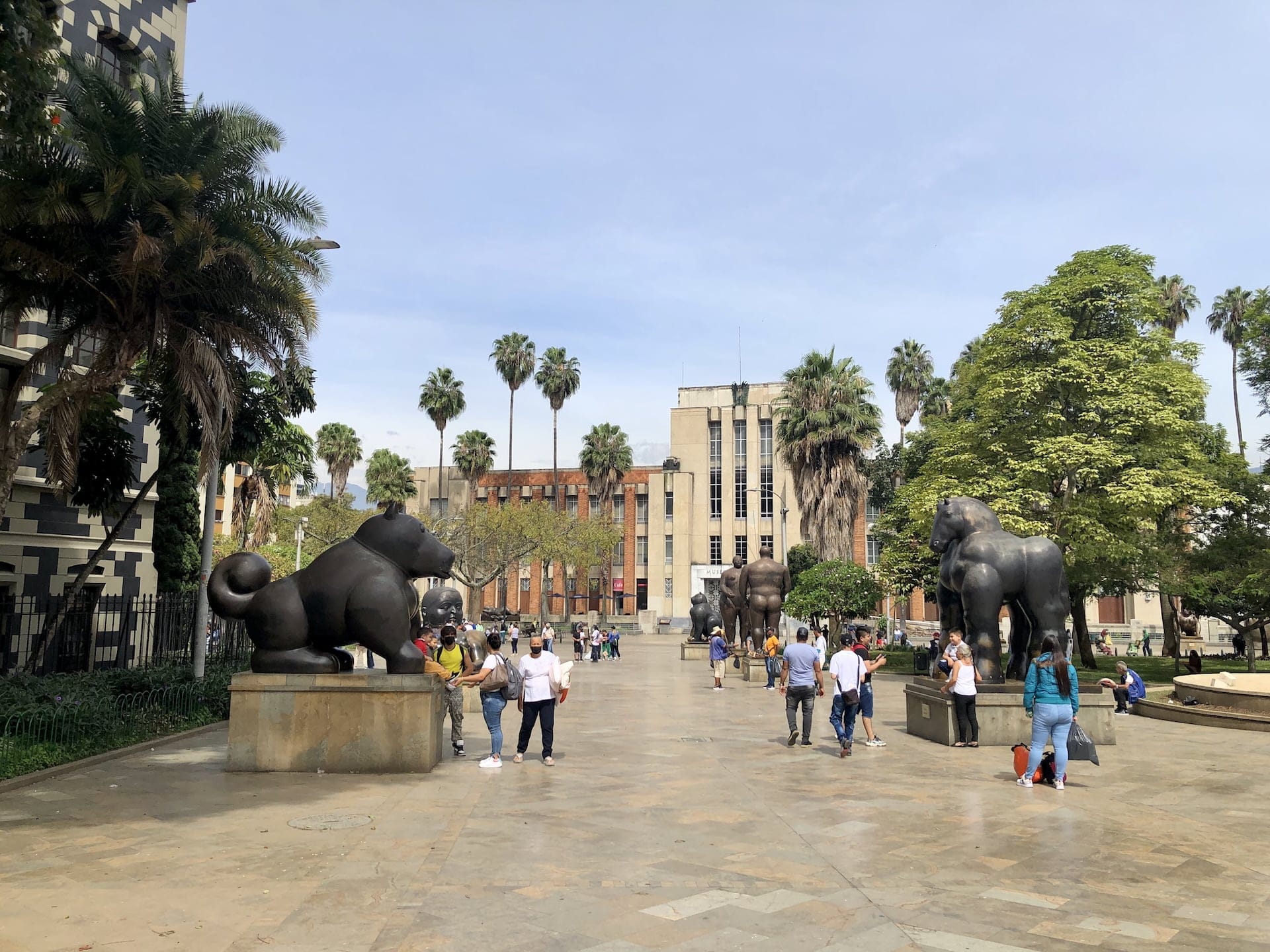
On the western side of the square sits the Museo De Antioquia, housed in a much less remarkable building than the cultural palace. This was Antioquia province’s first museum and Colombia’s second. It’s an art museum with permanent exhibitions that naturally include a significant Botero collection, including the Escena con Jinete mural. Admission for foreigners is 40,000 COP (~$10 USD), and the museum is open Monday through Saturday from 10:00 AM to 5:30 PM, and Sundays and holidays from 10:00 AM to 4:30 PM.
From Plaza Botero, we strolled along Carrera 52 toward the San Antonio metro station. On this few-hundred-meter stretch, we first encountered the Iglesia de la Veracruz church—surprisingly Medellín’s only colonial-style church. Construction began in 1682, though not in its current form. Interestingly, the altar was brought directly from Spain.
Continuing along Carrera 52, we passed countless vendors before reaching one of the area’s most fascinating buildings: the Centro Comercial Palacio Nacional. Built in 1933 and originally housing Antioquia government offices, it was renovated in 1993 to accommodate a shopping center on the lower floors. A local told us it’s also called the “shoe mall,” where you can find many shoes and clothing items of questionable authenticity. What’s truly exciting, however, is the beautifully renovated interior space and the galleries and exhibition spaces on the third through fifth floors. Several cafes dot the building, and on the fifth floor, a terrace wraps around the structure offering great views of the city. It’s definitely not your everyday shopping center.
When visiting Plaza Botero, go early in the morning to avoid crowds and have better opportunities for photos with the sculptures. The light is also better for photography before midday.
Parque Conmemorativo Inflexión
As we mentioned in our other post, the Poblado neighborhood or its immediate vicinity offers ideal accommodation. While exploring this district during daylight hours, consider venturing slightly further south. Just one metro stop away at the Aguacatala station and a brief walk beyond lies the Parque Conmemorativo Inflexión. This powerful memorial park occupies the site of Pablo Escobar’s final residence, the Mónaco building—razed in 2019 to make way for this solemn tribute.
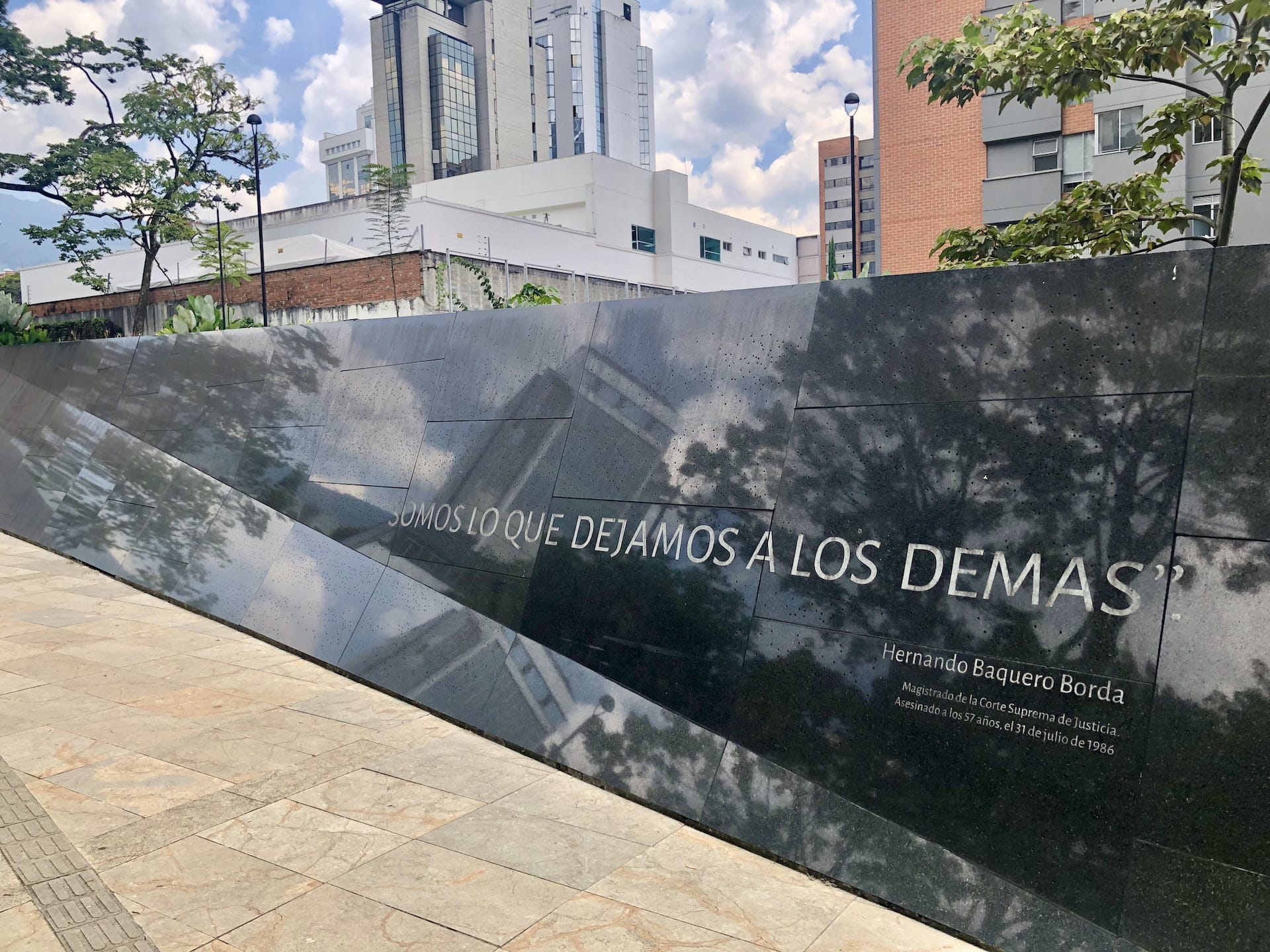
The park commemorates the harrowing period of narco-terrorism between 1983 and 1994 and honors Escobar’s countless victims. From the entrance, a contemplative path guides visitors through nine obsidian monoliths inscribed with haunting quotes from murdered public figures.
This path culminates at a striking 70-meter-long, 5-meter-high black stone wall. One side bears 46,612 precisely drilled holes—each a silent witness to a victim of the drug cartels in Medellín during this dark chapter. The opposite face documents the location, time, and nature of 208 violent events. The emotional weight is staggering as you contemplate that during this era, the simple act of venturing outdoors carried mortal risk in Medellín, with bombings and attacks claiming innumerable innocent souls. On any ordinary morning, leaving for work meant carrying the shadow of uncertainty about returning alive.
During our visit, pleasant birdsong filled the park, with the silence occasionally broken by the laughter of children running beside strollers in the shadow of the dark walls. The stark contrast between the memorial and its peaceful present environment effectively conveys Medellín’s essence: the contrast between a terrible past and a hopeful present and future. The memorial park is profoundly moving and definitely worth visiting—it tangibly illustrates the devastating impact of Pablo Escobar’s reign of terror.
Visit the park in the morning when it’s less crowded, and take time to read the stories and information displayed. Photography is allowed, but be respectful of the memorial’s significance.
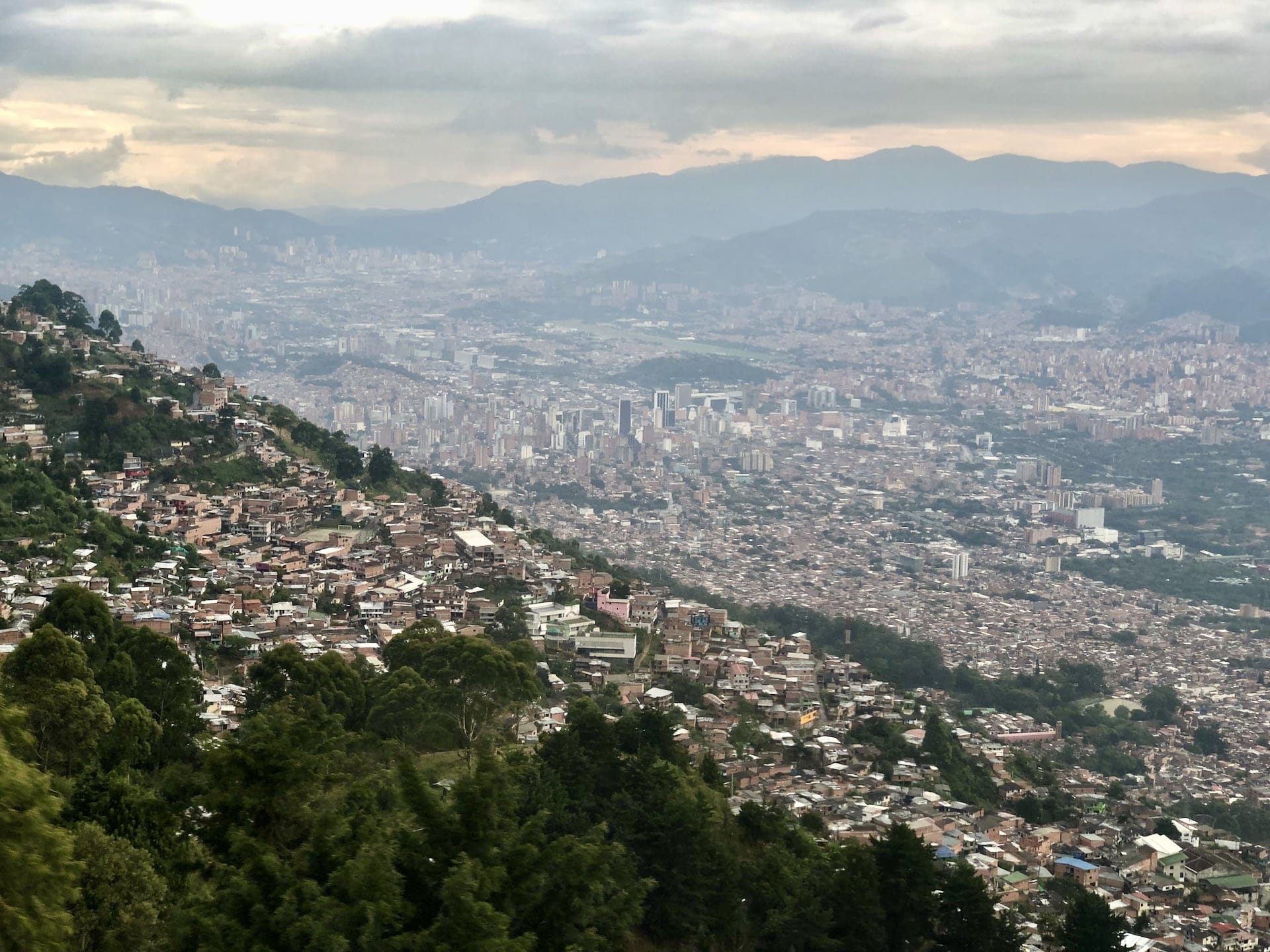
Museo Casa de la Memoria
Also telling the story of Medellín’s troubled past is the Museo Casa de la Memoria. We arrived by tram, which is an interesting experience itself: it’s an extension of the B metro line to the east, and because of the hilly terrain, it runs on rubber tires instead of rails. The tram departs from the central San Antonio station, and from there it’s two stops to Bicentenario, from which the museum is about a 200-meter walk.
The building’s distinctive architecture announces itself from a distance. Admission is completely free, with opening hours spanning 9:00 AM to 6:00 PM on weekdays and 10:00 AM to 4:00 PM on weekends. Inside, various exhibitions chronicle Medellín’s violent era through survivor testimonies presented in video format. While the subject matter proves compelling, we found the museum’s execution somewhat lacking—partly because most information appears exclusively in Spanish, limiting international visitors’ comprehension.
The Poblado Neighborhood and Surroundings
The pulsating heart of Poblado is Parque Lleras, around which the legendary local nightlife revolves, but this district warrants exploration during daylight hours as well. After visiting Inflexión Park, we walked back to Poblado along Carrera 43A. This route offers excellent views of the lower parts of the city and highlights the stark contrast with neighborhoods perched even higher on the hillside. (Come to think of it, Medellín truly is a city of contrasts.)
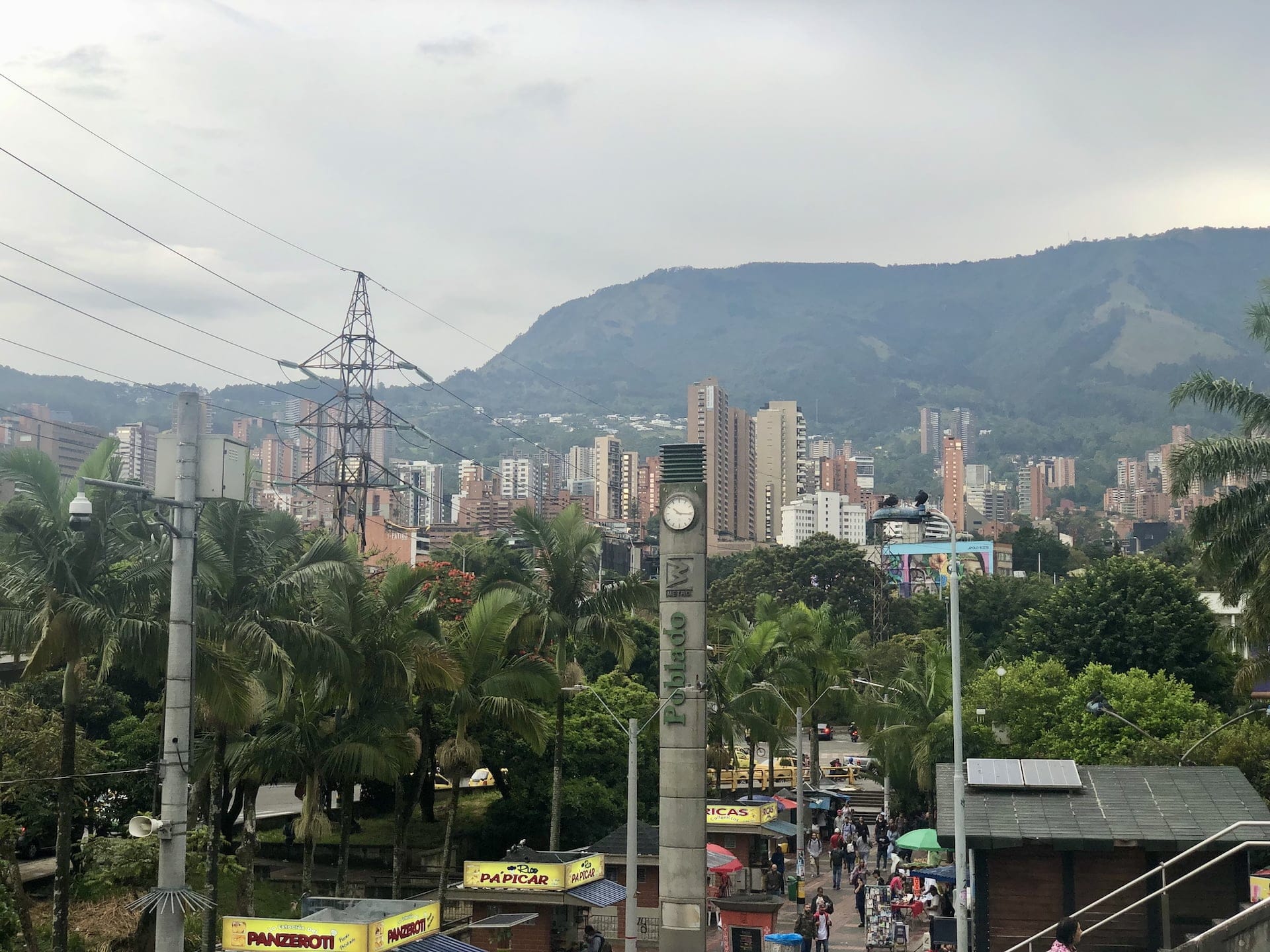
If you choose this route, you’ll pass the area’s enormous shopping malls. Perhaps the most popular is Centro Comercial Santafé Medellín, though mall-hopping isn’t really our thing, so we skipped the interior exploration.
We also explored the area around Parque Lleras during the day when the streets are much quieter (by Latin American standards). Here we enjoyed a beer in front of a tienda—a brilliant local concept where small shops set out tables and chairs so you can immediately enjoy your cold purchased beer. Soon after, a small group of locals arrived. One man was clearly having a good day and, without prompting, bought us a round when he noticed we were finishing our drinks. With our limited “caveman-style” Spanish vocabulary (restricted to variations of “thank you” and “how are you?”), we couldn’t really converse, which he didn’t seem to expect anyway. After exchanging a few pleasantries and buying rounds for each other’s groups, we resumed our explorations.
Another key landmark is Parque de El Poblado. Though not particularly spectacular (with the Iglesia de San José church along one side), it serves as the launching point for most day excursions, so familiarizing yourself with routes between your accommodation and this plaza proves beneficial.
The Parque Lleras area transforms completely at night. Countless venues spring to life, music blares from every direction (unfortunately mostly reggaeton instead of traditional cumbia), and establishments actively try to draw in customers. For early arrivals, happy hours abound. If you’re seeking clubbing, dancing, and drinking, this area is ideal, especially east of the park (e.g., Vintrash). However, if you want to test your salsa skills with locals (quite the challenge), Poblado isn’t your best bet. The top salsa bars are found in the Laureles neighborhood (e.g., Son Havana Bar, though they maintain a location in Poblado too).
For an authentic nightlife experience in Poblado, arrive around 10 PM when locals begin filling the bars and clubs. Drinks are significantly cheaper during happy hour (usually 5-8 PM), but the real atmosphere develops later.
Botanical Garden
I must begin with two confessions. First, botanical gardens don’t particularly excite me—though Peter enjoys them, so I decided to give it a chance. Second, we never actually made it to the local botanical garden, the Jardín Botánico Joaquín Antonio Uribe de Medellín. This wasn’t for lack of trying; we attempted twice. The garden sits right beside the Universidad metro station, and admission is free (when it’s open). Even locals couldn’t explain why it was closed multiple times, but checking the website now, I see it closes on many days in early September for “private events,” which might explain our experience.
Among the garden’s premier attractions stands the Orchideorama (architecturally remarkable in its own right), which provides optimal conditions for the exquisite orchid collection. Beyond orchids, thousands of flowers, distinctive trees, and representatives of 139 bird species inhabit the grounds. Reportedly, numerous iguanas congregate near the lake—a sight we missed due to the locked gates.
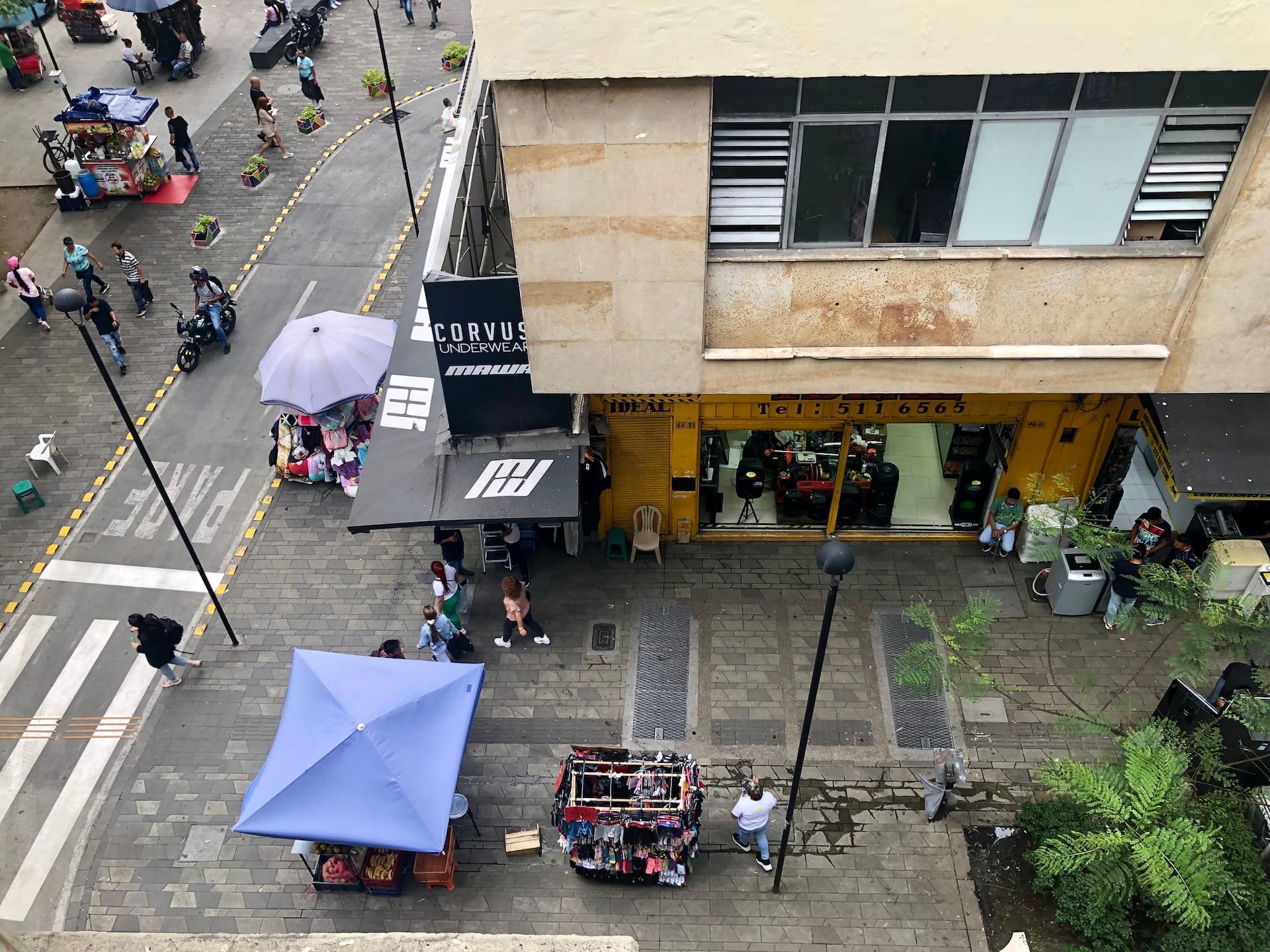
Museum of Modern Art
I was struck for the second time by traveler’s diarrhea in Medellín (perhaps a relapse of my Minca adventure), so unfortunately I missed this museum, which sits very close to Poblado—accessible either on foot or by taking one metro stop to Industriales. The Museo de Arte Moderno de Medellín impressed me from the outside (which I did manage to see), and based on its 4.7 average rating from 12,000 Google reviews, the contents must be equally impressive—Peter certainly enjoyed it.
The museum is closed on Mondays, open on other weekdays from 11:00 AM to 7:00 PM, and on weekends and holidays from 11:00 AM to 6:00 PM (they seem to appreciate a leisurely morning). Admission for foreigners is 24,000 COP (~$6 USD), granting access to both permanent and temporary exhibitions. It’s worth checking the museum’s website for information about current exhibitions.
The museum offers free admission on the last Friday of each month from 4 PM to 6 PM, though expect larger crowds during these hours.
Parque Arví
This adventure almost qualifies as a day trip in itself. The formally named Parque Regional Ecoturístico Arví is a massive 16,000-hectare (39,500-acre) nature reserve east of downtown Medellín. The journey alone makes it worth visiting: first, take the A metro to Acevedo station, then the K gondola (Metrocable) all the way to Santo Domingo terminal. The city views are already spectacular from here, but the best is yet to come—the L Metrocable carries you to Parque Arví with breathtaking panoramic vistas throughout the journey.
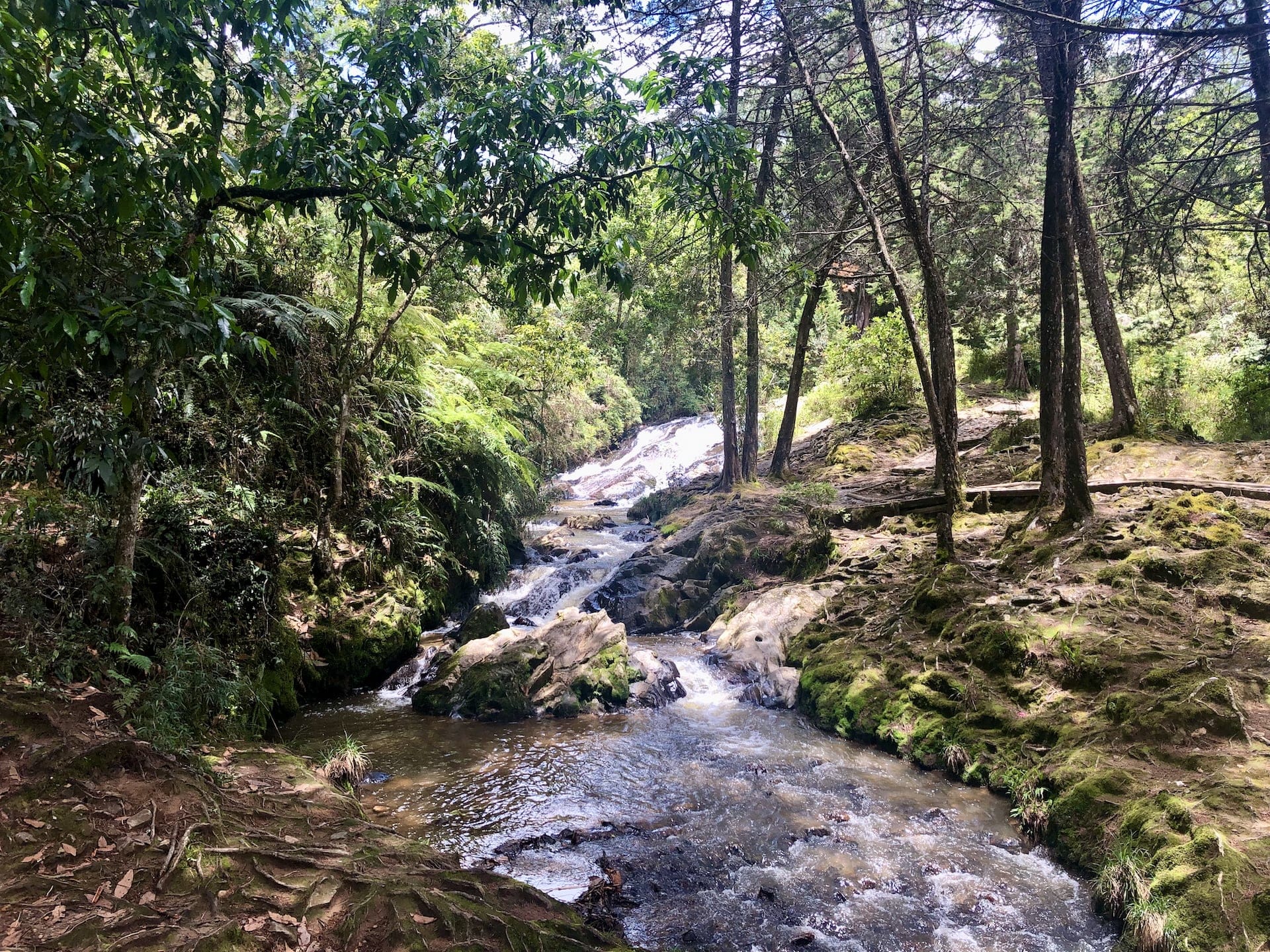
Note that the L line operates outside the integrated transportation network and requires a separate fee of 12,500 COP ($3 USD). Additionally, the park entrance fee is 30,000 COP ($7 USD), making this a relatively expensive outing by local standards.
We weren’t sure if guided tours were included in the ticket price, and suspecting they were only offered in Spanish, we didn’t participate due to our limited language skills at the time. These tours depart every half hour along numerous routes—check the park’s website for details. Nevertheless, you can explore perfectly well without a guide, though we occasionally asked for directions. Maps available at the metro station mark the various paths. Don’t worry about needing serious hiking gear; most trails are well-built and maintained. We walked to the lake, where simple restaurants offer refreshments and there are boating opportunities. Unfortunately, a torrential downpour caught us there—just as my digestive issues began resurfacing—so we caught a bus back to the Metrocable terminal for our return journey.
Start your visit to Parque Arví early to avoid crowds and afternoon rain showers, which are common in Medellín. Pack water, snacks, and a light rain jacket even if the morning begins clear and sunny.
Comuna 13
I’ve saved perhaps the city’s most famous and popular attraction for last: Comuna 13. This neighborhood deserves its own comprehensive article to fully cover its history and significance (and perhaps we’ll write one!). Comuna 13 is one of Medellín’s hillside districts that was once considered among the most dangerous areas in the world, with an astronomical crime rate and abysmal living conditions.

We visited as part of a guided tour, which I wholeheartedly recommend to everyone. This was unquestionably the most fascinating and enlightening tour of our entire Colombian trip, with enormous thanks to our guide, Sebastián, whom we found through Airbnb (now available on GetYourGuide too). The tour, called Comuna 13 & Downtown: From Violence to Innovation, explores not just the famous comuna but also the path that led there—both physically and historically.
Starting from Botero Park, we took a short walk to the metro, then rode the B line to its terminus before transferring to the J Metrocable to its final stop. Throughout the journey, Sebastián shared the city’s history and explained why the integrated mass transit network played such a pivotal role in Medellín’s remarkable transformation. Born and raised in the city and educated in architecture and urban planning, Sebastián offers unparalleled insights. (Interestingly, after practicing at various architectural firms, he transitioned to tour guiding because it provides better livelihood—a revealing commentary on local economic dynamics.)
Without spoiling all the fascinating details, here’s the essence: by building an efficient and accessible public transportation system, the time and energy required to travel from higher elevations to downtown drastically decreased. This made commuting to workplaces feasible, significantly improving employment opportunities. Additionally, public institutions like libraries and schools were strategically built at major transportation hubs, bringing education and culture within reach of disadvantaged residents. The results speak for themselves: crime has plummeted, and Comuna 13—once possibly the world’s most dangerous neighborhood—has blossomed into a vibrant area buzzing with cultural programs that tourists eagerly explore. (Although, undeniably, Operation Mariscal and Orion in 2002 also “helped,” when helicopters, tanks, and hundreds of soldiers flooded the area to permanently eliminate the guerrilla groups and gangs.)
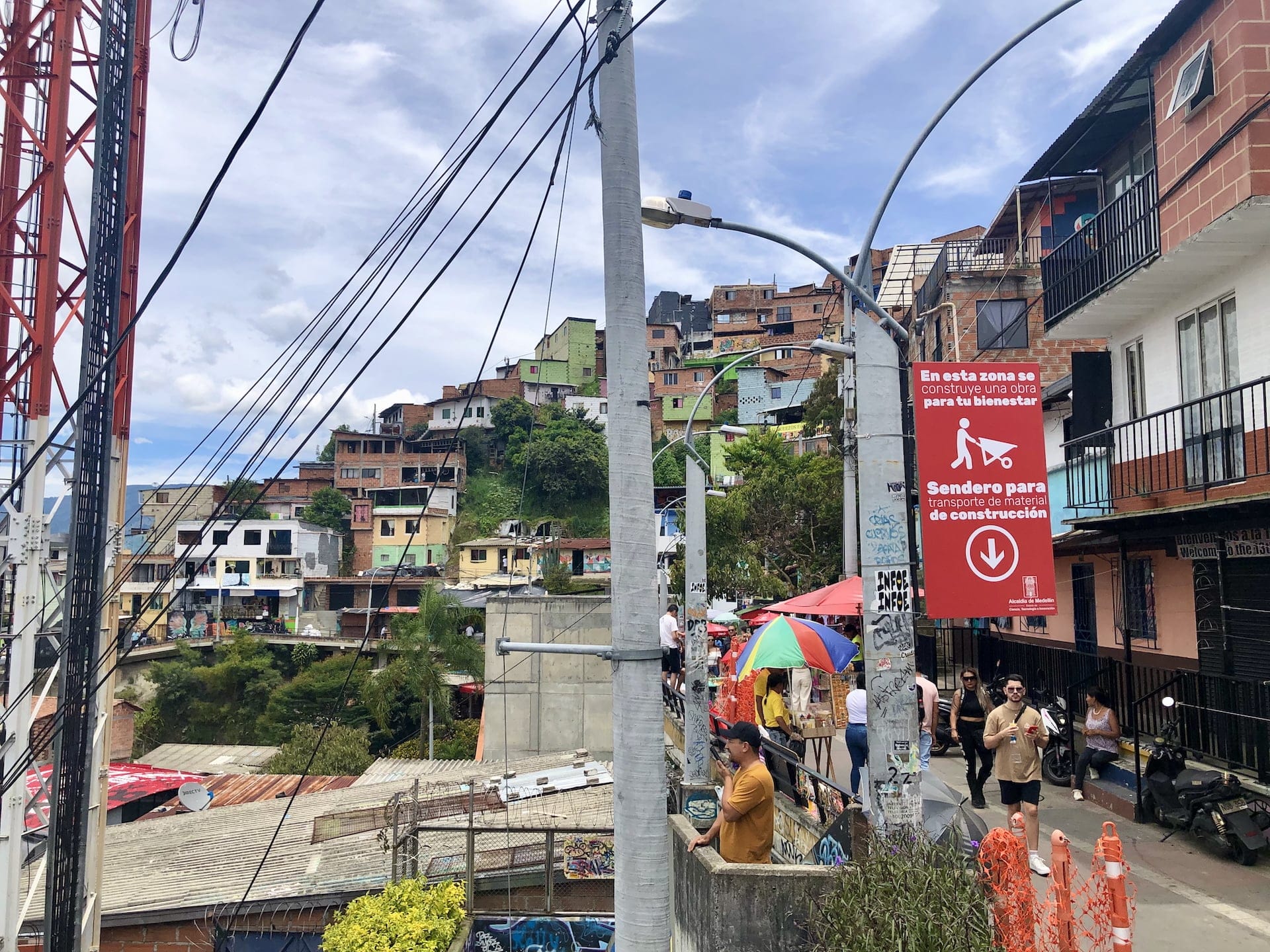
As we navigated Comuna 13’s pathways, Sebastián continued his engaging narrative. The primary challenge with these essentially illegally constructed dwellings was infrastructure deficiency. The introduction of proper sidewalks provided not just improved mobility for residents (and the ability to transport building materials) but also accommodated previously non-existent sewer systems beneath and electrical networks above (which simultaneously supply street lighting). Virtually every available space adjacent to these walkways has been transformed into community areas—basketball courts, performance stages, and gathering spots where residents forge connections. Beyond sidewalks, proper staircases now traverse the steep terrain (some featuring adjacent slides for children’s delight!), including the world’s only escalator system functioning as an integral component of public transportation infrastructure (remarkably remaining free to use).
For the most authentic Comuna 13 experience, book a small group tour with a local guide who has personal connections to the area. They can provide insights you won’t get from larger commercial tours and introduce you to local artists and entrepreneurs who are revitalizing the community.
Deeper into Comuna 13, amid spectacular street art, we encountered breakdancers and small stands selling specialty micheladas (some with gummy bears!) and cocktails in front of their owners’ homes. Colombians everywhere demonstrate remarkable resourcefulness and business acumen: some enterprising residents, for example, open their bathrooms for a small fee, saving tourists the discomfort of holding those micheladas too long. Sebastián occasionally treats the group to local specialties like arepas, empanadas, or ice cream, and always provides water. (Naturally, we reciprocated by treating him to several rounds of “refreshments” not included in the tour price.)
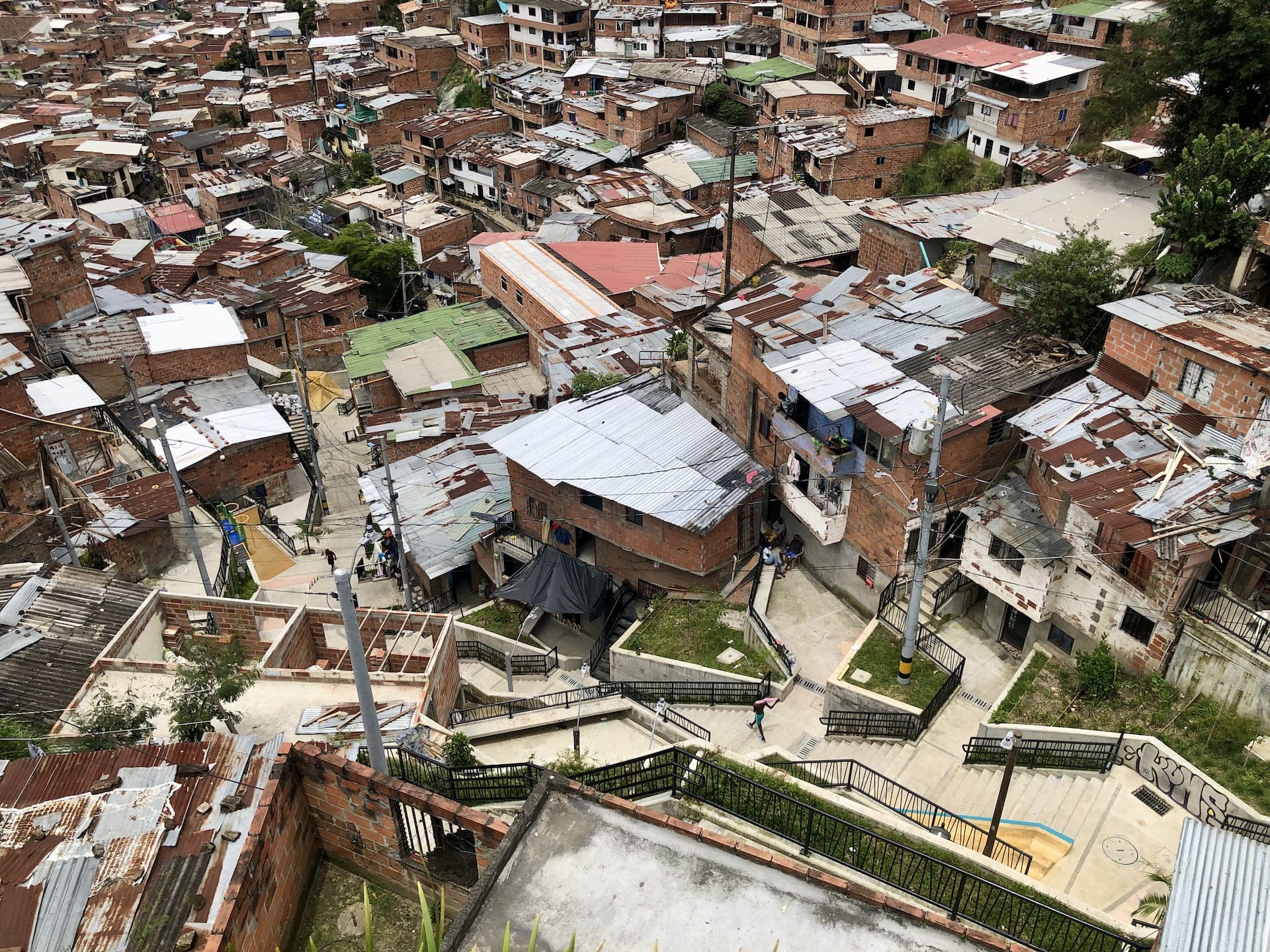
Comuna 13 has transformed dramatically from its notorious past. While the physical structures haven’t changed significantly, the atmosphere and people have evolved tremendously—and this vibrant energy justifiably attracts visitors. Perhaps it’s even become too popular; weekends bring extreme crowds, and even on weekdays, you sometimes feel like you’re walking through an open-air museum rather than an authentic neighborhood. Regardless, it remains an absolute must-see when visiting Medellín!
Best Day Trips Around Medellín
El Peñol Rock and Guatapé
This is undoubtedly the most popular day trip from Medellín. You can easily choose a well-rated excursion from GetYourGuide or Tripadvisor; most offer similar itineraries.
These tours typically start early with a bus ride followed by a quick breakfast, which in our case wasn’t particularly memorable (most tours likely use the same couple of establishments). Soon after, you arrive at the main attraction—the rock.
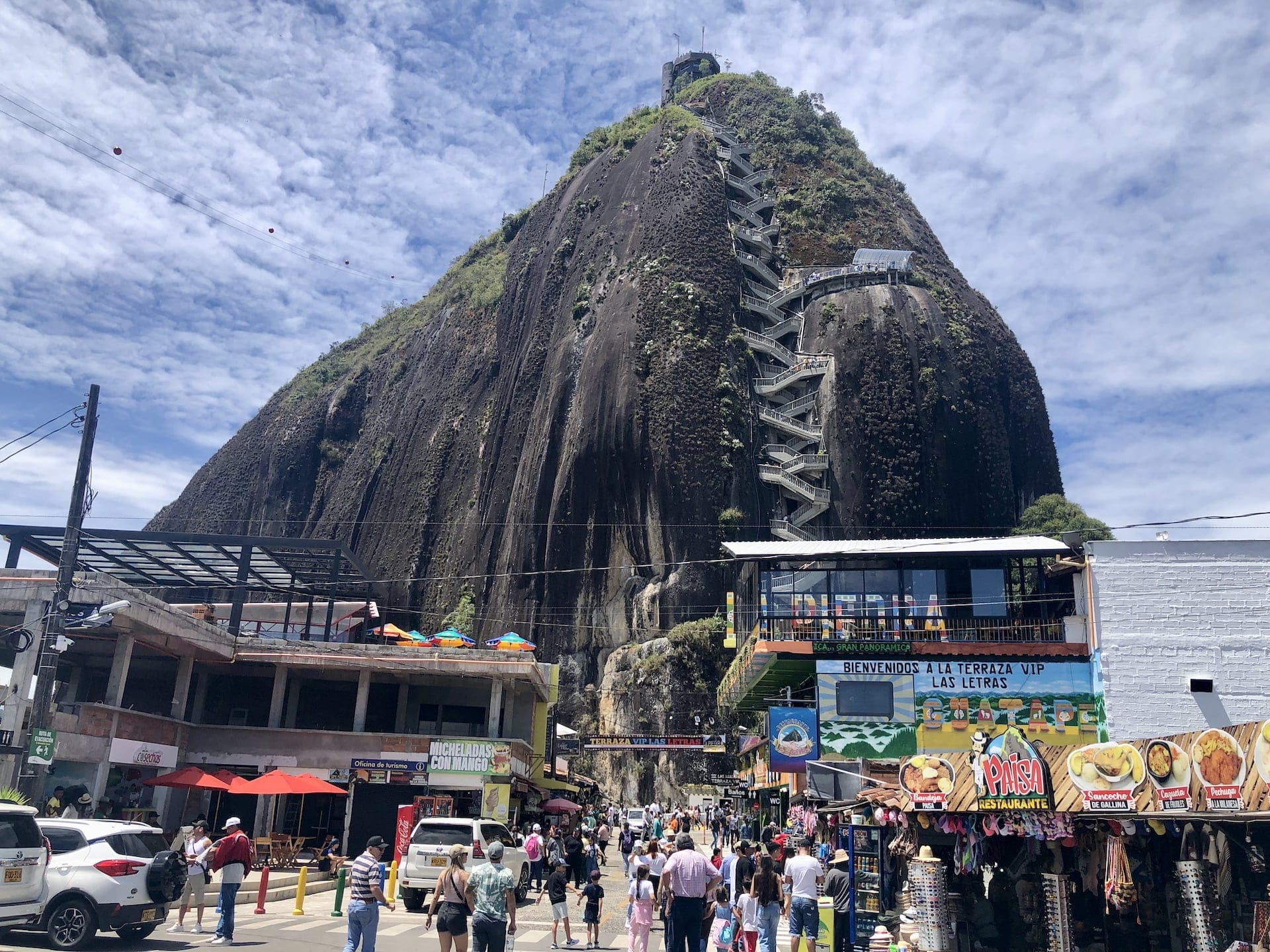
And it’s truly impressive. El Peñol is a colossal granite monolith rising over 200 meters (656 feet) with a distinctive sugar-loaf shape that geologists estimate to be 65 million years old. After navigating through the maze of vendors and souvenir shops at its base, you’ll discover another surprise: accessing the rock requires payment. At 30,000 COP (~$7 USD), it’s relatively expensive by Colombian standards and typically not included in tour prices. This fee exists because the rock is privately owned. An enterprising man named Luis Eduardo Villegas López (who was also the first to climb El Peñol) purchased it from local farmers in the mid-1950s. They considered it worthless—actually an annoyance since it occupied valuable farmland. According to local legend, López paid just two cows for the rock, an investment that has yielded an extraordinary return, as evidenced by the crowds now paying to climb it.
Reaching the summit requires ascending 708 steps. With average fitness, this isn’t overly demanding—we completed it in about 15-20 minutes—but some in our group found it challenging. Older visitors or those with mobility issues should consider whether the climb suits their abilities. The reward at the top is a spectacular panoramic view of the surrounding landscape with a lake system and dotted with islands. The jagged shorelines aren’t natural formations but rather the result of the artificial lake system created when the Guatapé dam was built in the 1970s, flooding the area. After taking in the breathtaking views, you can refresh yourself with a cold beer from the café conveniently located at the summit.
When visiting El Peñol, wear comfortable shoes with good grip as the steps can be slippery when wet, and bring cash as vendors at the summit don’t necessarily accept cards. The most striking photos of the rock itself are actually taken from the road approaching Guatapé town.
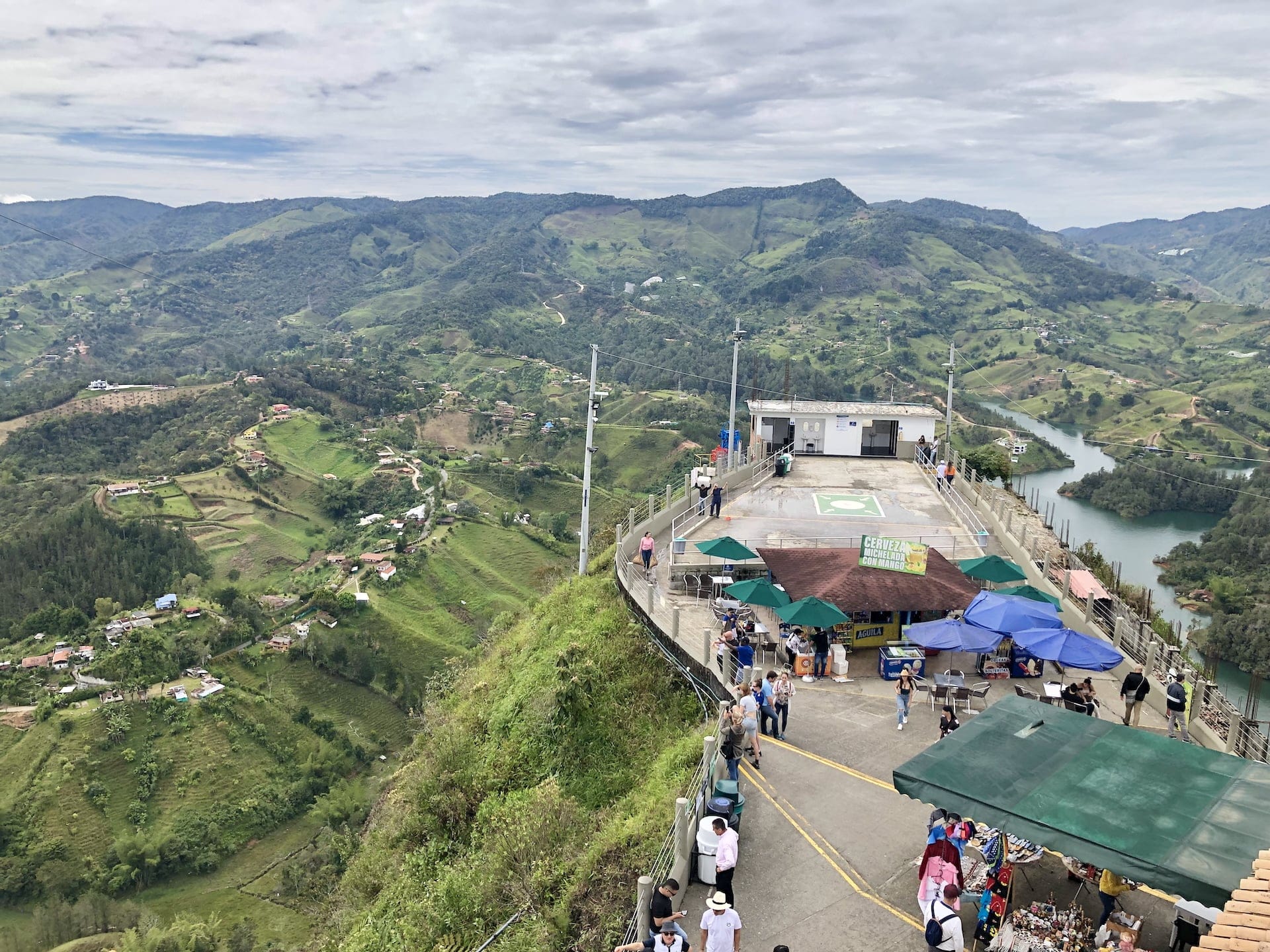
While your tour operator determines the schedule, it’s apparently advantageous to time your climb strategically. Afternoons bring larger crowds to the narrow stairs, creating bottlenecks that significantly extend climbing time. Mornings often start foggy but offer fewer people. We arrived around 9 AM when the stairs were relatively empty (allowing us to ascend quickly), and although the morning began foggy, the haze lifted shortly after we reached the top, gradually revealing the stunning landscape. Based on our experience, morning is definitely the optimal time.
Following the rock adventure, most itineraries proceed to Guatapé town. Several minutes into this drive, you’ll glimpse the rock from an alternative perspective and notice something curious: white letters approximately 20 meters (65 feet) high spelling “GI” on its face. This doesn’t represent homage to G.I. Joe but rather an abandoned attempt to inscribe “GUATAPÉ” in monumental scale. The two proximate communities, El Peñol and Guatapé, have long contested ownership of the landmark. Guatapé residents once attempted to resolve the dispute dramatically by claiming the rock through this enormous declaration. Predictably, El Peñol citizens rapidly detected the operation and mobilized their entire population to “persuade” their neighbors to cease (reportedly bringing weapons to reinforce their argument). The intervention proved effective, and the painting project remains perpetually unfinished—a monument to inter-village rivalry.
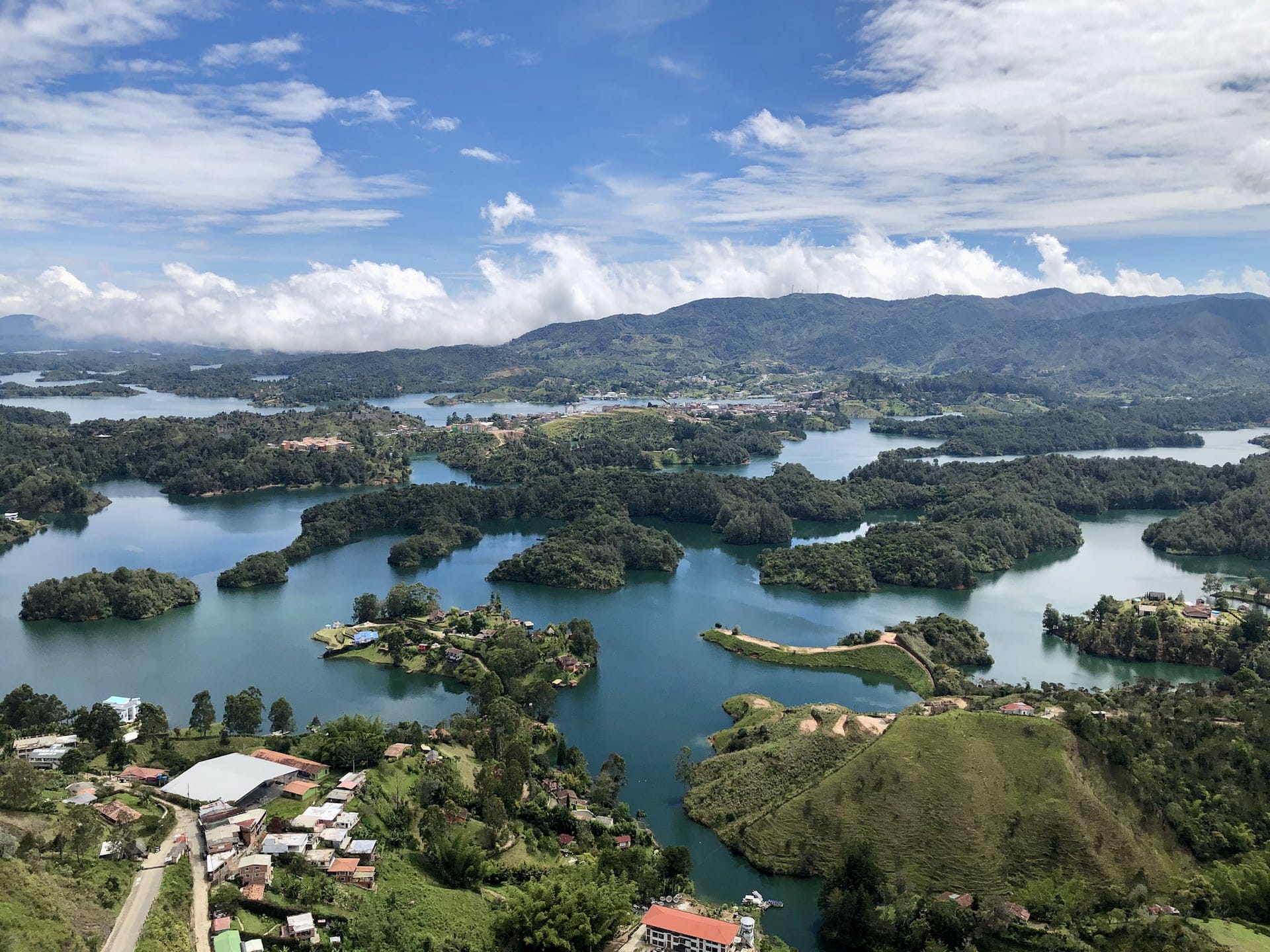
(We at Streets and Summits take no position in this sensitive territorial dispute. Although we typically refer to it as El Peñol, we certainly don’t wish to antagonize Guatapé residents. The rock is officially known by two names: El Peñón de Guatapé and La Piedra de El Peñol—though personally, I think El Peñón del Peñol would have the nicest ring.)
The subsequent destination is Guatapé proper, renowned for its vibrantly colorful houses adorned with various decorative patterns. The town center has been beautifully restored; the main square features the Parroquia Nuestra Señora Del Carmen Guatape church, and two blocks away lies the Plazoleta de Los Zócalos. Be prepared for a thoroughly touristic experience—you’ll encounter many international visitors, and the entire town has adapted to tourism with features seen in many global tourist destinations, such as umbrella-covered streets and tuk-tuks (quite foreign to traditional Colombia).
Nevertheless, it’s worthwhile to explore the charming streets, enjoy a coffee and fresh juice (we relaxed at a café on the aforementioned square), and perhaps observe authentic paisas going about their daily lives. (Colombia features two predominant cultural groups with distinct dialects: the paisas inhabit the inner Andean regions, while the costeños live along the Caribbean coast.)

Most tours allocate free time in Guatapé (we also received lunch by the waterfront, which, typical for such excursions, wasn’t particularly memorable), followed by a visit to Réplica del Peñol. As the name suggests, this is a small collection of reconstructed buildings showcasing the architecture and character of the original El Peñol town. When the Guatapé dam was constructed, the resulting artificial lake completely submerged the area where El Peñol once stood—a development probably less lamented by Guatapé residents—and its inhabitants were relocated. Here you can browse souvenir shops and view historical photographs of the former town.
The final highlight is approximately a 45-minute boat cruise on the lake system. The boats typically sell cold beer, allowing you to savor the scenery with a refreshing drink in hand—and despite being man-made, the landscape is genuinely beautiful. Interestingly, parts of this area were previously owned—directly or indirectly—by Pablo Escobar. During the boat trip, you’ll pass his estate called La Manuela, which served as the cocaine kingpin’s “weekend retreat.” The buildings remain standing today, or what’s left of them after Los Pepes’ bombing attack using 200 kg of TNT in 1993.
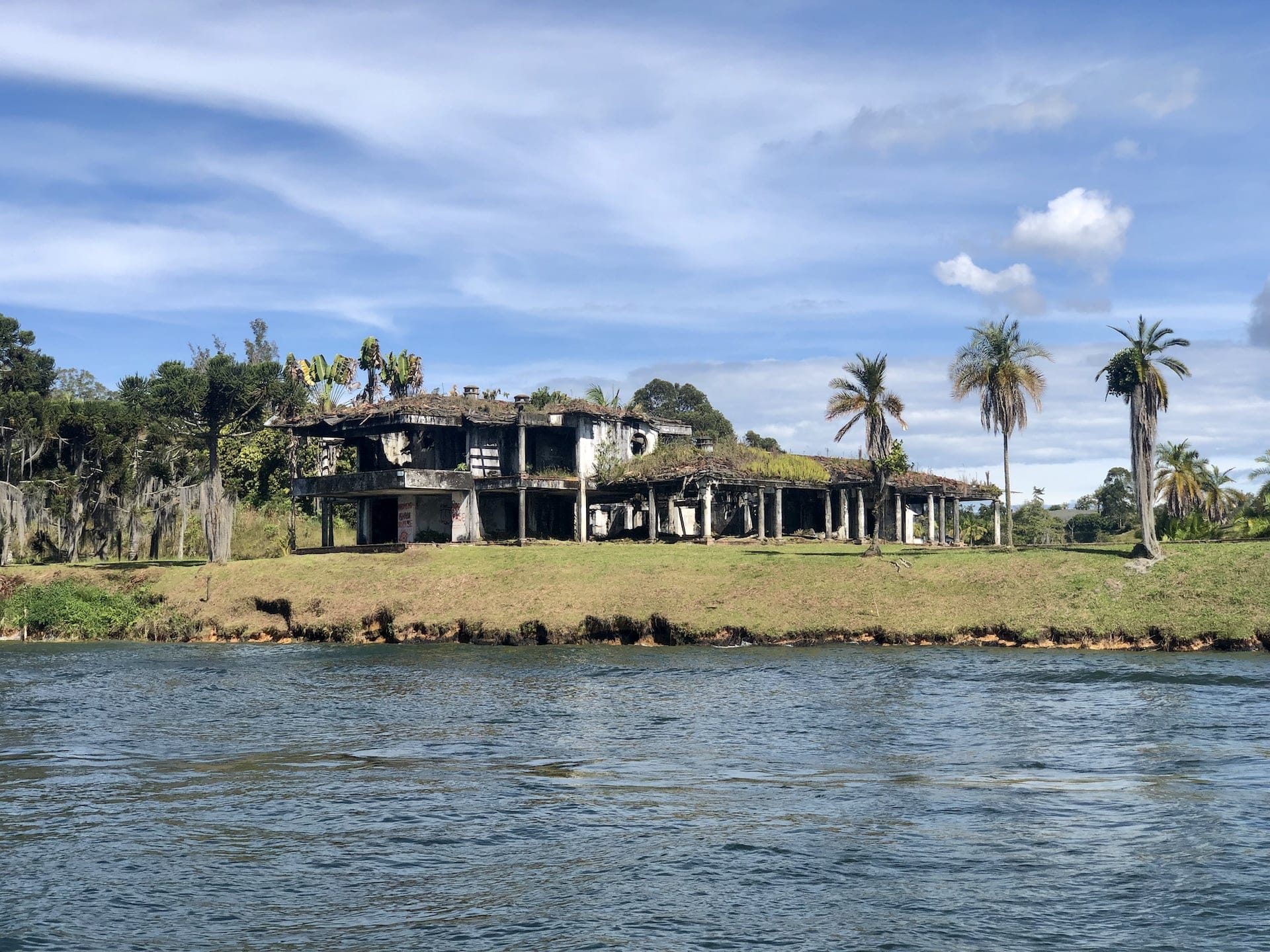
The boat cruise concludes your day’s adventures, after which your transportation returns you to Medellín, typically to the Poblado district depending on your tour provider. This constitutes a comprehensive full-day excursion, usually spanning 10-12 hours from morning departure to evening return, so prepare accordingly with water, snacks, and other necessities.
Santa Fe de Antioquia
Another option if you want to leave Medellín for a day is visiting Antioquia province’s former capital, Santa Fe, which is about an hour and a half from the city. We took the comfortable route and only visited Guatapé, so I’ll write briefly about this place based on others’ accounts.
Santa Fe was founded in the mid-1500s and served as Antioquia province’s capital for nearly 250 years (until 1826). It’s known as “Cuna de la Raza Paisa” (Cradle of the Paisa Race). The town offers a much more tranquil experience—and attracts far fewer tourists—than Guatapé, while still showcasing abundant traditional colonial architecture with whitewashed centuries-old houses, churches, cobblestone streets, and pleasant parks.
Beyond the charming streets, buildings, and churches, the main highlight is the Puente de Occidente, a suspension bridge built in 1887 that holds Colombian National Monument status. Most tours also include the Juan del Corral Museum, featuring exhibitions about the town’s era as provincial capital.
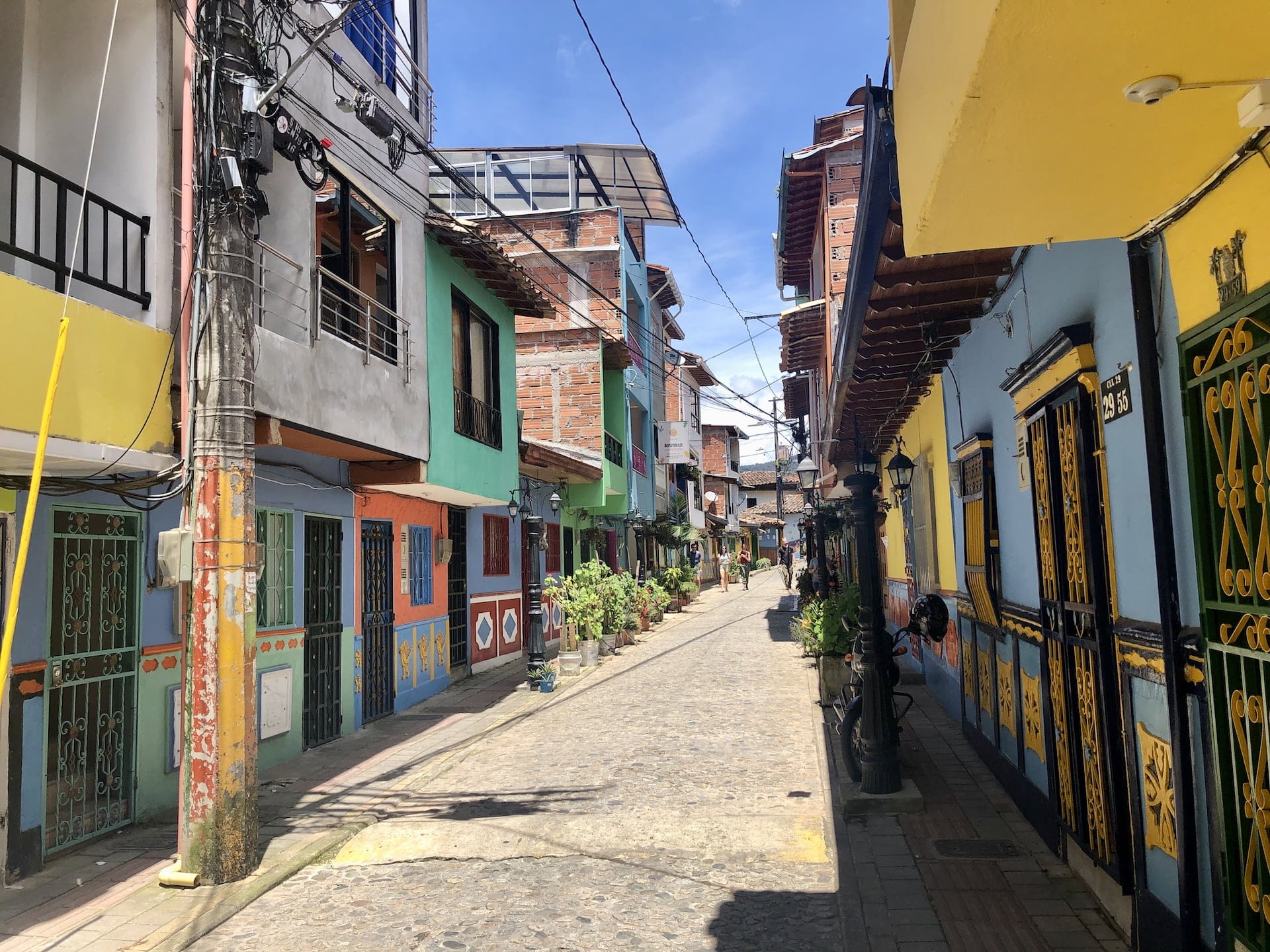
What We Ate and Drank in Medellín
Being a huge cosmopolitan city popular among foreigners, Medellín has a fairly wide range of food and drink scenes. Most of the time, we grabbed an empanada or arepa from street vendors during the day, so we didn’t delve too deeply into the restaurant world, but here are a few places that impressed us.
Hija Mia NOMADA
This café was a few meters from our Airbnb, so we had breakfast here on our first morning. Then on all the others too. While not a traditional local establishment—it clearly caters to tourists and digital nomads—every dish was absolutely delicious, and their house-roasted coffee was exceptional. Breakfast/brunch items cost around 40,000 COP (~$10 USD), placing it among the pricier options, but this daily indulgence quickly became a cherished ritual we anticipated each morning.
Foxey Pub
This establishment was practically adjacent to our Airbnb (don’t worry, we did venture further). A craft beer house, or more accurately a beer marketplace, where various small breweries operate their own counters across multiple floors for sampling their creations, with food options also available. While comprehensive tasting of the entire selection would have constituted quite the ambition (and questionable judgment), we tested a substantial portion of the offerings and found all the beers excellent. The service is friendly and efficient, and the rooftop terrace provides views of the bustling street below. The venue opens at 4 PM and operates until 1 or 2 AM depending on the day—timing that wasn’t always ideal for us as next-door neighbors.
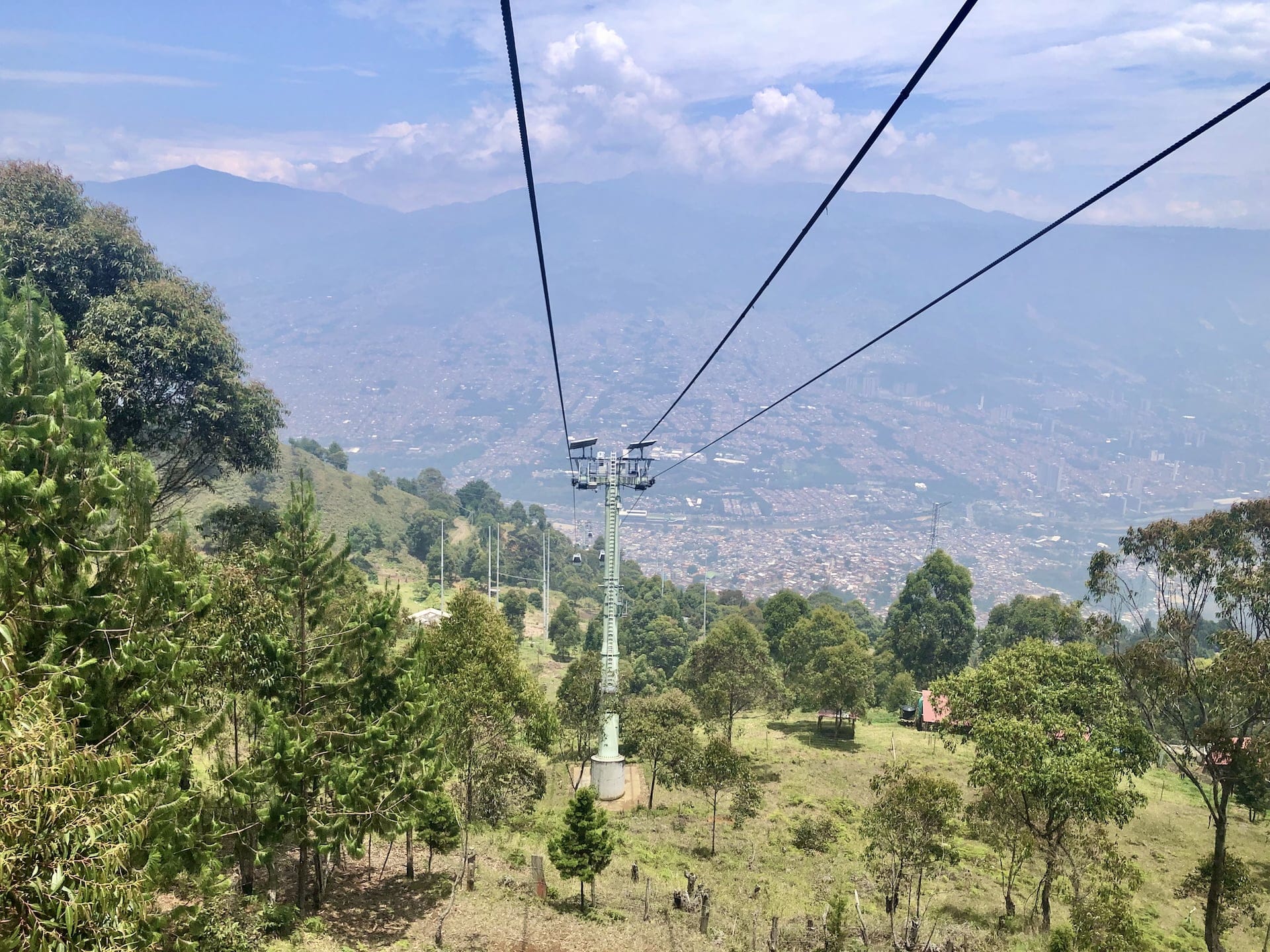
Pizzaiolo
Though Colombian—and Latin American—cuisine is wonderful, sometimes familiar comfort food calls. While we’re not Italian, authentic Neapolitan pizza holds a special place in both our hearts. When we read Google reviews from actual Italians claiming they found the continent’s best pizza here, we had to investigate. Despite the high turnover and popularity, it’s absolutely worth visiting. While I can’t say for sure that there’s no better pizza in all of South America, Pizzaiolo certainly didn’t disappoint us. Be prepared for premium prices (for Colombia), however—the most basic pizza (Margherita) costs around 40,000 COP (~$10 USD) as of 2025.
37 Park Medellín
I mentioned above that we’re not exactly the party animal type, so we skipped the really big and popular clubs. At this charming spot, however, you can enjoy beers or cocktails and simple food near the action without being overwhelmed by it. The establishment features a spacious outdoor “terrace”—essentially some log seating, tables, and chairs in a park setting. It’s perfect for pre-gaming before diving into Medellín’s vibrant nightlife or for a relaxed evening drink.
Mercado del Río
On our final Medellín day, persistent precipitation drove us toward indoor shelter. Near Poblado (a brief walk from the Industriales metro station) stands this “market”—actually a sophisticated gastronomy hall housing numerous diverse culinary enterprises. Options span the globe from Asian to Peruvian to traditional Colombian cuisine, plus dedicated bar and dessert venues. With rainfall battering the exterior, we enjoyed beer, main courses, and desserts at three different establishments. It’s also perfectly situated for a quick lunch before or after visiting the Museum of Modern Art.
For the best experience at Mercado del Río, visit during weekday lunch hours (12-2 PM) when it buzzes with local office workers and offers the most authentic atmosphere.
Summary: Medellín in a Nutshell
Medellín offers visitors a fascinating blend of urban renewal, cultural richness, and natural beauty. Once notorious as one of the world’s most dangerous cities, it has transformed into a vibrant metropolis that proudly showcases its journey from violence to innovation.

The city’s highlights include Plaza Botero with its distinctive sculptures, the powerful Inflexión Memorial Park that thoughtfully confronts Escobar’s violent legacy, and the revitalized Comuna 13 neighborhood where colorful street art and community spirit have replaced crime. Medellín’s efficient public transport system, particularly the innovative Metrocable gondolas, provides both practical transportation and spectacular views of the entire valley.
For day trips, El Peñol rock and the colorful town of Guatapé stand out as must-visit destinations, offering insight into the region’s natural beauty and cultural heritage. The food scene caters to all tastes, from local Colombian cuisine to international options, with craft beer venues and specialty coffee shops reflecting the city’s cosmopolitan character.
What elevates Medellín beyond mere tourism is the profound metamorphosis etched into its very soul—a testament to the unbreakable spirit of its people who refused to surrender to the darkness that once engulfed them. Here stands a city that doesn’t merely acknowledge its harrowing past but incorporates those painful chapters into a narrative of hope, creating something beautiful from the ashes of tragedy. Every colorful mural, every innovative transit solution, every vibrant plaza tells the story of phoenixlike rebirth. With 3-5 days, visitors can experience Medellín’s main attractions at a comfortable pace, though many travelers find themselves wanting to stay longer in this dynamic city nestled in the “Valley of Eternal Spring.”

